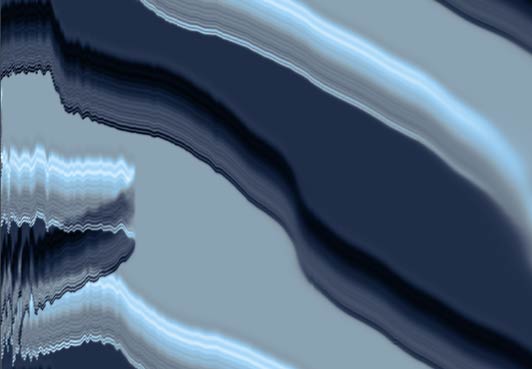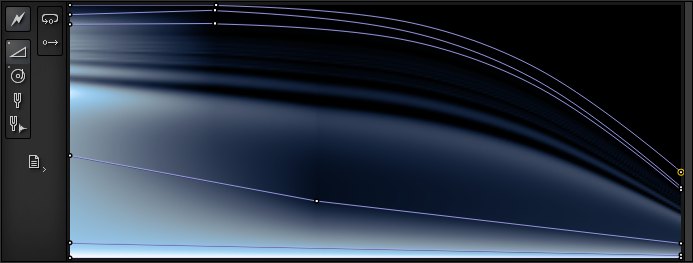|
Cycle pioneers a new form of synthesis―a marriage of spectral synthesis and CAD-like waveform design. It's a powerful combination that opens up many undiscovered sound design possibilities. |
The Grand Design
Cycle has a visual workflow for synthesizing sound at the waveform and spectrum level.
Using points and lines to design waveshapes and spectral filters, you have the power to add detail where it is needed and directly create the character of the sound you're after. The result is a capable and productive sound design process.
Part of this design philosophy is to visualize as much as possible, providing you with a graphic representation of the output signal - one that is updated in realtime whenever a change is made.
With this in mind, the user interface shows different views of the signal and its spectral information. Each perspective doubles as an editor for the curve 'wireframe' that contributes its part of the signal processing chain.
Wherever possible, Cycle sets no limits. There are unlimited points in a curve, unlimited spectral layers, waveshape layers, deformer curves, scratch envelopes, and unison voices.
Signal Flow
The processing steps, for each cycle of the signal:

- 1. Waveshape curves are calculated and summed up to make the total waveshape.
- 2. It's spectral information is analysed, producing the magnitude and phase spectra.
- 3. Magnitude curves are calculated - depending on their mode, these either multiply or add to the magnitude spectrum.
- 4. Phase curves are calculated - they add to the phase spectrum.
- 5. The spectral data is transformed back into the time-domain, reconstructing the filtered signal.
- 6. The single-cycle is smoothly joined with previous cycles, and the signal is processed by the effects. The voice-time is advanced, and the process will be started again for the next cycle.
Spectral layers have filtering and additive modes, and with no limit on the number of layers, you can build up complex filters and resonances.
(See SIGNAL FLOW to get a full picture of the processing chain.)
Flexibility
Cycle is designed to have superlative flexibility, because static sounds are boring.
The curves that create waveshapes, spectral filters, and envelopes don't just have the ability to morph, they can morph in 3 dimensions. So instead of transforming from configuration A to B, a curve can transform between eight configurations. Juicy!
The basic idea is that the curve points have 8 positions they "remember" and the final position is determined by combining them with different weighting. The weighting is controlled by modulation sources, like voice-time or note velocity.
So, as these modulation values change, so too do the weightings and the curve points can take different arrangements, transforming the curve.
There are a huge number of possible modulation sources, and in tandem with the Modulation Matrix, you can route them to different parts of the signal processing chain.
Effects
- Unlimited voice unison with anti-phasing and individual voice tuning.
- Impulse Modeller - design a filter's custom impulse response at up to 16000 samples long.
- Programmable waveshaper with up to 8x oversampling.
- Convolution reverb.
- 5-band EQ.
- Delay with revolving pan.
- 240+ HQ factory presets
- Up to 16x oversampling
- Zero-latency DSP algorithms
- Highly optimized signal processing
- OpenGL rendering for high graphic performance
Formats
On Windows, Cycle is offered as a standalone, 32 bit and 64 bit VST plugin.
On OS X 10.6+ it is offered as standalone, VST plugin, Audio Unit variants. The plugin formats in OS X are universal 32/64 bit binaries.

Modulation Matrix.

User Interace. The unified interface shows all workflow on one page. Resizable to fit your screen area.
More info.

Player Mode. When not editing, the UI can be reduced for a smaller footprint.

Magn. Spectrogram Editor. The spectrogram displays the sound's spectrum as it evolves over time.
More info.

Phase Spectrogram Editor. This is the visualization of the unwrapped phase over time. The patterns revealed here are very
useful for modelling instruments.

Waveform Surface. This is how the signal is represented in the waveform surface. Cycles of the signal are juxtaposed in
columns as if you were looking down from above―showing all of the signal's data from beginning to end.
More info.

Waveshaper. Get crunchy distortion sounds with the programmable waveshaper. Use this effect in combination
with the Impulse Modeller for electric guitar synthesis.

Morph Panel. The morph position and morphing workflow controls.

Waveshape Editor. In the foreground is the current layer's waveshape as defined by points and lines.
Behind is the signal after it has been processed by the other parts of the synth
(filters, unison, effects, etc). More.

Spectrum Editor. 2D spectrum editing view showing curve morphing paths over Yellow, Red, and Blue morphing ranges.

Phase Spectrum Editor. The phase spectrum can be distorted to add breathiness, detune harmonics, and make organic timbres.

Envelopes. Shown is the volume envelope with decay, loop, and release regions. Cycle has three types: volume, pitch,
and scratch envelopes. Unlimited in number, the scratch envelopes can be assigned to layers to distort
the timeline, making it easy to create punchy sounds or loop regions like an LFO.
More info.

3D Envelope View. An envelope as it transforms along a morphing range. Voice-time is the y-axis.

Deformer Paths. A deformer curve can be used as automation path of a vertex position, and can also be a component curve of waveshapes,
filters, and envelopes. The volume envelope shown above has 3 component deformers. They are an efficient way to add
detail to the sound. More info.

Impulse Modeller. This effect lets you design an arbitrarly complex filter. It can mimic the sound of
guitar amplifiers and provides a tool for auto-fitting the curve to cabinet IR samples.

Preset Browser. Cycle's preset browser lets tag, rate, search, and share presets. You can download new
presets by other users from the central server. The multi-keyword search feature in combination
with tagging means presets are quick to find and organize.


